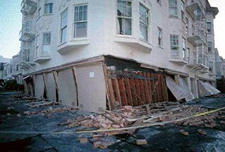Basic Seismic Terminology
 General Background
General Background
The evening news usually reports the strength of an earthquake as a number on the "Richter Magnitude Scale". This is not a precise measure of the severity of an earthquake.*
The severity of an earthquake at any particular place is called "intensity" and is calculated from the amount of ground motion measured at that place. The intensity of an earthquake at a location is affected by many factors including the distance from the earthquake's epicenter and the nature of the underlying rock and soil. Damage to structures is related to how hard the earth shakes in that given geographic area and is expressed in g (gravity) as a decimal or percentage. The scale or method used by the State of California is to measure ground displacement (acceleration) at a particular location as a percent of g. or gravity. The Landers California earthquake of June 28, 1992 produced a ground displacement of at least one g. as their three million gallon reservoir, was lifted approximately one meter off the ground, then dropped, splitting its seams and instantly dumping its water.
* Source: "Damages and Losses From Future New Madrid Earthquakes." David Stewart, Associate Professor, Department of Earth Sciences, Center for Earthquake Studies, Southeast Missouri State University, August 1991.
Standards
The State of California has standards established in ASCE 25-97 Document for Earthquake Actuated Automatic Gas Shutoff Devices. Early 2000 AWWA recommended the water industry adhere and adopt those same standards.
Why does FLOLOC calibrate its seismic sensor in "percent of g"?
FLOLOC adheres to the requirements set by the State of California. The standard setting for FLOLOC seismic sensors is .3g., the point just before which damage to valves and distribution systems may occur. FLOLOC’S seismic sensor is factory set and adjustable to your requests.
Below is a rough corelationrelationship between the Moment Magnitude (Richter), Mercalli to Acceleration (decimal or % of g), Velocity and potential damage
ROUGH GUIDE
MAGNITUDE (degrees),INTENSITY, ACCELERATION (g)
| Richter Magnitude |
Instrumental Intensity (Mercalli) |
Acceleration (g) PGA |
Velocity (cm/s) PGV |
Perceived Shaking |
Potential Damage |
| 1.0 - 3.0 I | I | < 0.0017 | < 0.1 | Not Felt | None |
| 3.0 - 3.9 | II-III | 0.0017 - 0.014 0 | 1.1 | Weak | None |
| 4.0 – 4.9 | IV | 0.014 - 0.039 | 1.1 - 3.4 | Light | None |
| 4.0 – 4.9 | V | 0.039 - 0.092 | 4 - 8.1 | Moderate | Very Light |
| 5.0 – 5.9 | VI | 0.092 - 0.18 | 8.1 - 16 | Strong | Light |
| 5.0 – 5.9 | VII | 0.18 - 0.34 | 16 - 31 | Very Strong | Moderate |
| 6.0 – 6.9 | VII | 0.18 - 0.34 | 16 - 31 | Very Strong | Moderate |
| 6.0 – 6.9 7.0+ | VIII | 0.34 - 0.65 | 31 - 60 | Severe | Moderate to Heavy |
| 6.0 – 6.9 7.0+ | IX | 0.65 - 1.24 | 60 - 116 | Violent | Heavy |
| 7.0+ | X+ | > 1.24 | > 116 | Extreme | Very Heavy |
Earthquake Terminology
Accelerations
Accelerations due to gravity - the vertical acceleration with which a ball falls if released at rest in a vacuum (to eliminate wind resistance). Value = 1.0g. Horizontal acceleration due to earthquakes is often expressed as a percent of gravity or %g. For example if a body weighs 100 pounds and receives a lateral earthquake force of 20 pounds, that can be expressed as a force of 20%g. (0.2g.). A vertical earthquake force in excess of 100%g. (1.0g.) will throw any object regardless of size or mass into the air.
Peak horizontal acceleration - maximum measurement of horizontal ground motion produced by earthquakes; stated as a percent of gravity (1.0g.).
Earthquakes
Earthquake mitigation - planning, legislation, education and activities accomplished before an earthquake which will lessen damages to life and property during and after a seismic event. This is one area where FLO LOC's products can help!
| Any Earthquake of magnitude | Earthquake rating/name |
| 2.9 or less | Very Minor Earthquake |
| 3.0 - 3.9 | Minor Earthquake |
| 4.0 - 4.9 | Light Earthquake |
| 5.0 - 5.9 | Moderate Earthquake |
| 6.0 - 6.9 | Strong Earthquake |
| 7.0 - 7.9 | Major Earthquake |
| 8.0 or greater | Great Earthquake |
Epicenter - the point on the surface of the earth directly above the focus of an earthquake.
FEMA - Federal Emergency Management Agency. The Federal Agency with lead responsibility for implementing the National Earthquakes Hazards Reduction Program (NEHRP), including planning, coordination, assistance to state and local programs, public education and coordination of federal response to catastrophic earthquakes.
Focus - the point within the earth's crust from which earthquake waves first originate.
Frequency - the number of waves that pass a fixed point each second. The most damaging frequencies of seismic wave range from two (2) cycles per second to as slow as one (1) cycle in three or four seconds.
Intensity (of earthquakes) - a measure of the effects of an earthquake at a particular place. Intensity depends no only on the earthquake's magnitude but also on the distance from the epicenter and on the local geology. Intensities tend to be greatest in areas underlain by wet sand or clay. See also "Earthquakes".
Liquefaction - the sudden transformation of soil into a fluid. Repeated earthquake vibrations can cause a loose, water-saturated sand to suddenly lose all of its shear strength or internal friction and collapse.
Magnitude (of earthquakes) - a measure of earthquake size, determined by taking the common logarithm (base 10) of the largest ground motion recorded during the arrival of a seismic wave type and applying a standard correction for distance to the epicenter.
Modified Mercalli Scale - measures, subjectively, the effects of a seismic event at a particular distance from its epicenter.
Richter scale - or Richter Magnitude Scale - a numerical scale of magnitude devised by C. F. Richter in 1935 which describes the magnitude or amount of energy released by an earthquake at its source. That numerical scale of magnitude was succeeded in 1970 by the Moment Magnitude Scale and is used by seismologists to estimate the size of earthquakes. It has become customary, in statements to the press, to call it "Richter". This is not a precise measure of the severity of an earthquake at a site.
Seismic waves - the disturbances propagated outward from the focus of an earthquake.
Body waves - seismic waves that travel through the earth. There are two kinds of body waves: P waves and S waves. The P wave, sometimes called the "primary wave" because it travels it travels faster and arrives first, is a compression wave, vibrating in the direction of propagation. The S wave, sometimes called the "secondary wave" because it arrives after the P wave, is a shear wave, vibrating at right angles to the direction of propagation.
Surface waves - seismic waves that travel only along the surface of the Earth.
SCADA - acronym for Supervisory Control And Data Acquisition.
Seismogram - the record made by a seismograph.
Seismograph - an instrument for recording as a function of time the motions of the Earth's surface that are caused by seismic waves.
USGS - United States Geological Survey. The federal agency with responsibility for determining earthquake potential, earthquake prediction, earthquake information, earthquake hazards and risk assessments and technical assistance in fostering implementation of loss-reduction measures.
Our products and services assist in loss protection and secondary loss prevention.
